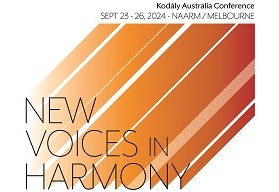Free Resources
Kodály Australia is pleased to provide FREE resources to support Australian Kodály-inspired teaching and learning.
Permission to use the resources hosted on the Kodály Australia website is granted through open access principles. This includes acknowledging Kodály Australia (KMEIA Inc). Resources may not be used for commercial gain unless written permission is obtained.
| Reference Charts | |
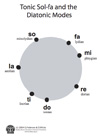 |
Diatonic Modes Creators: Darren Wicks and Gabriel Federow Download A reference chart that can be used for teaching scales, modes, intervals and harmony. The chart demonstrates intervallic relationships of all the diatonic tones. Suitable for senior secondary and tertiary students. |
 |
Handsign Diagram Creator: Darren Wicks Download A diagram of the Curwen hand signs commonly used in the application of the Kodaly concept. This sheet can be given to students or displayed in the classroom/studio as a ready reference. |
 |
Keyboard Diagram Creator: Darren Wicks Download This chart may be used to explain keyboard theory, intervals and scales to your students. Spacing and size of keys is based on a real keyboard. Using a keyboard chart (such as this) before moving students onto real keyboards can assist with classroom management issues often associated with group keyboard classes. |
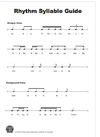 |
Rhythm Guide Creator: Darren Wicks Download A guide to rhythm duration syllables commonly used by Australian teachers who employ the Kodaly concept. Some regional variations in the syllables do occur. |
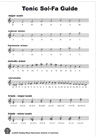 |
Tonic Sol-fa Guide Creator: Darren Wicks Download A reference chart for use of tonic sol-fa with diatonic scales and scale tone triads. |
Classroom Resources
| Flash Cards | |
| These cards are designed to practise the reading of common rhythmic and/or melodic patterns. The patterns reflect common melodic and rhythmic sequences used by Australian Kodaly educators. Setup for these flash cards is A4 size with two flashcards to a page. My suggestion is to print the files, photocopy them onto stiff card. Slice each card in half and then laminate for a set of durable classroom resources. | |
 |
Pitch Set 1 Creator: Darren Wicks Download Four beat melodic fragments incorporating the following elements: Tone set: do, re, mi Rhythm set: ta, ti-ti, ti-ka-ti-ka. Suitable age group: Middle School (Years 5 to 8). |
 |
Pitch Set 2 Creator: Darren Wicks Download Four beat melodic fragments incorporating the following elements: Tone set: do, re, mi, so Rhythm set: ta, ti-ti, ti-ka-ti-ka. Suitable age group: Middle School (Years 5 to 8). |
 |
Pitch Set 3 Creator: David O’Keefe Download Melodic fragments using the pentatonic scale and stave notation (F, G and C = do). |
 |
Rhythm Set 1 Creator: Darren Wicks Download 4 beat rhythmic patterns incorporating the following rhythmic elements: ta, ti-ti and sa (crotchet, paired quavers and the crotchet rest). |
 |
Rhythm Set 1 (Primary School) Creator: Jill Meneely Download 4 beat rhythmic patterns (without note heads) suitable for use in the Primary School. |
 |
Rhythm Set 2 Creator: Darren Wicks Download 4 beat rhythmic patterns incorporating the following rhythmic elements: ta, ti-ti and ti-ka-ti-ka (crotchet, paired quavers and 4 semi-quavers). |
 |
Rhythm Set 3 Creator: Darren Wicks Download 4 beat rhythmic patterns incorporating (1) Even divisions of a beat used in Rhythm Set#1 and #2 (2) Uneven divisions of single beat: ti-tika and tika-ti (common quaver + semiquaver combinations). |
 |
Rhythm Set 4 Creator: Darren Wicks Download 4 beat patterns incorporating the minim (half note). |
 |
Rhythm Set 5 Creator: Darren Wicks Download 4 beat rhythmic patterns incorporating all rhythmic elements from sets #1 to #4 and tam-ti (dotted crotchet-quaver). |
| Games and Activities | |
| Ideas for fun and games in the classroom. | |
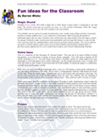 |
Fun Ideas for the Classroom #1 Creator: Darren Wicks Download Games and quick ideas for enthusing students in the Upper Primary/ Lower Secondary age group. |
 |
Let’s Practice Creator: Darren Wicks Download A list of practical ideas for using the Kodaly Teaching tools to practise musical elements. Suitable age group: Middle years (5 to 8). |
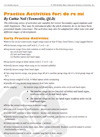 |
Practising do-re-mi Creator: Cathie Neil Download Over 30 ideas for practising the melodic tone set do-re-mi.Suitable age: secondary-aged students or older beginners |
| Worksheets and Handouts | |
| Activity sheets you can copy and use in the classroom. | |
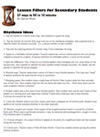 |
Lesson Fillers Creator: Darren Wicks Download 27 ideas for filling in ten minutes in the Middle School classroom. |
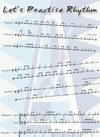 |
Rhythm Worksheet #1 Creator: Darren Wicks Download Challenging reading activities for the older beginner using the rhythmic elements ta and ti-ti.Suitable age: Middle years (Years 5 to 8) |
Free Resources
Latest News
NEW Member Resources
I am pleased to announce the launch of a refreshed Kodály Australia Member Portal. All members of Kodály Australia may now use the Member Portal to access an online repository of resources and professional learning. To access these resources, please explore the branch …
Read more
ASME XXV National Conference 2025
The Australian Society for Music Education (ASME) XXV National Conference will be held from September 26 to 29, 2025, at the Queensland Conservatorium, Griffith University. The call for paper and workshop presentations has been extended until this Friday, 14 February 2025. As …
Read more
Season’s Greetings from Kodály Australia
As we near the end of 2024, I extend my warmest wishes on behalf of Kodály Australia for a joyful festive season and new year ahead. This year, there has been an extensive offering of professional learning activities provided for …
Read more
Congratulations Katharine Finlayson
Congratulations to Katharine Finlayson (ACT) who has been awarded Honorary Life Membership of Kodály Australia. Honorary Life Membership is Kodály Australia’s highest accolade and is given in recognition of an individual’s ongoing and highly significant contribution to the association and …
Read more
1000 Active Members!
Dear Members I am pleased to share that Kodály Australia recently recorded over 1000 active members in our database. This is an incredible achievement for our community and worthy of acknowledgement. Please know that your continued membership of Kodály Australia …
Read more

